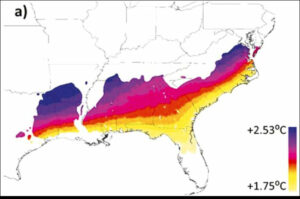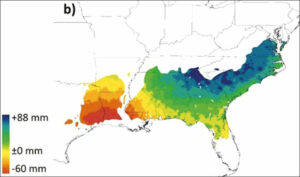
Projected temperature increases in the range of loblolly pine in 2040-2059 time frame under IPCC worst case scenario
Despite rising temperatures, increasing concentrations of carbon dioxide (CO2) in the atmosphere will give a 30.4% productivity boost to the growth loblolly pine forests in Virginia and 11 other Southeastern U.S. states by 2060, according to recent research from Virginia Tech.
The research team lead by Harold Burkhart, professor of forestry, modeled the effects of increased ambient CO2 concentrations and the interaction of changing climate and C02 enrichment on loblolly pines, which constitutes more than half of total pine volume.

Change in precipitation in loblolly pine range in 2040-2059 time-frame under worst-case IPCC scenario.
The study, “Regional Simulations of Loblolly Pine Productivity with CO2 Enrichment and Changing Climate Scenarios,” assumed that CO2 levels will continue to increase in line with the Intergovernmental Panel on Climate Change’s worst-case RCP 8.5 scenario. It modeled the impact on a stand of planted loblolly of about 500 trees per acre growing until harvested after 25 years.States the article abstract in Forest Science:
While there are many caveats and assumptions underpinning the results, they suggest that while changes in climate have a moderately beneficial effect on productivity, increased atmospheric CO2 concentration has a much greater beneficial effect, with the mean predicted increase across the loblolly pine growing region in the 2040–2059 time period being 30.4% by 2060 under effects of both climate and CO2 enrichment in Representative Concentration Pathway (RCP) 8.5, the high greenhouse gas future scenario.
Bacon’s bottom line: It is commonly said that “global warming” is settled science. That claim is not merely wrong — it is philosophically meaningless. The “global warming” movement consists of a set of nested propositions, each with its own set of controversies, not a single unified claim.
The first proposition, an uncontroversial one, is that human industrial activity — increasing emissions of CO2, methane, and deforestation — is causing a steady increase in the percentage of CO2 in the atmosphere. The second proposition, somewhat more controversial, is that the higher percentage of CO2, a known greenhouse gas, is responsible for increasing global temperatures and will continue to push temperatures higher. While widely accepted, this proposition is not universally held. There are controversies over how accurately “global temperature” is measured. Further, skeptics contend that temperature forecasts are based upon hypothesized multiplier effects that remain unproven. The third proposition, more controversial still, is not even a scientific argument, it’s an economic one: that the impact of global warming will be uniformly negative and ruinous to the economy. The fourth proposition, essentially a philosophical argument, is that the best way to avoid those devastating negative impacts is to reduce the emissions of CO2 and methane into the atmosphere by re-engineering the energy economy, as opposed to, say, mitigating the impacts as they occur.
The Burkhart study touches upon the third proposition. To be sure, the study does not address the larger issues I am raising here, and for all I know, Burkhart might disagree with my perspective. But his study is consistent with the view that a higher CO2 concentration in the atmosphere — “CO2 enrichment” — improves the metabolic efficiency and stimulates the growth of plants generally. Admittedly, this argument has led to its own sub-set of controversies, with those alarmed by “global warming” claiming that an increase in plant mass in food crops is not necessarily accompanied by an increase in nutrition.
But people don’t eat loblolly pines. Loblolly pines are a raw material used in housing, furniture, pulpwood, plywood, composite boards, posts, poles, pilings, crates, boxes, and pallets. By boosting productivity in loblolly production, higher CO2 levels will prove beneficial to the economy — Virginia’s economy in particular. Virginia’s forestry industry contributes $17 billion a year to the state economy, according to the Virginia Department of Forestry.
By the time we take into account the impact of rising temperatures on global sea levels and the flooding of low-lying areas like Hampton Roads, the net impact of higher CO2 concentrations likely still will be negative. But any honest accounting — of which there has been precious little — will consider both positive and negative impacts.
The Burkhart article was published in August 2018. A condensation of that article in Appalachian Woodlands and Sportsment’s Review brought it to my attention.


